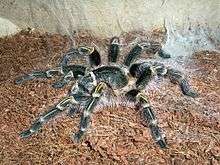Grammostola pulchripes
One of the larger species of tarantula, the Chaco golden knee (Grammostola pulchripes), formerly known by Grammostola aureostriata,[1] can be expected to reach between 20–22 cm (8.5 in).
| Chaco golden knee | |
|---|---|
 | |
| Scientific classification | |
| Kingdom: | Animalia |
| Phylum: | Arthropoda |
| Subphylum: | Chelicerata |
| Class: | Arachnida |
| Order: | Araneae |
| Infraorder: | Mygalomorphae |
| Family: | Theraphosidae |
| Genus: | Grammostola |
| Species: | G. pulchripes |
| Binomial name | |
| Grammostola pulchripes (Simon, 1892) | |
| Synonyms | |
|
Grammostola aureostriata Schmidt & Bulmer, 2001 | |
Name
The former (and very commonly used) species name, aureostriata, is derived from Latin aureus "golden" and striatus "striped". The currently used species name, "pulchripes," is derived from Latin "pulchra", meaning "beautiful", and "pes", meaning "foot".
Description and behavior
The Chaco golden knee is a large tarantula, being able to reach between 7 and 8 inches in legspan (17.8-20.3 cm). Being a terrestrial tarantula, it has a heavy body. Mature males have longer legs and smaller bodies than females, and they possess tibial hooks or apophyses to hold back a female's fangs during mating. Males also possess modified pedipalps to insert sperm into the female's genital operculum. It exhibits a multitude of colors, with bright yellowish leg stripes, dark black "femurs", and pink hairs all over its body. As with the rest of the genus Grammostola, the Chaco golden knee has very large fangs, and the carapace (the top of the prosoma) is raised to make room for the large chelicerae. It has rudimentary eyesight, and senses its environment with the setae all over its body, feeling vibrations through the ground and air, and picking up chemical signatures, similar to a sense of smell.
Natural habitat
The Chaco golden knee tarantulas are known to inhabit the grasslands of Argentina and Paraguay.[2] As such, they are adapted to generally warm climate, with alternating dry and rainy seasons.
As a pet
 G. pulchripes in captivity
G. pulchripes in captivity
The Chaco golden knee is a very calm and docile tarantula, which, along with its striking appearance and large size, makes it an attractive pet, especially for beginners. It frequently sits in plain view in captivity, and likes to shove substrate around, especially at young ages. Females can live for well over twenty years, while males only live for about five or six years. The tarantula must periodically molt its exoskeleton to grow larger, and it is vulnerable during this time. This can happen every few weeks for newborn spiderlings or every few years for large adults.
The Chaco golden knee tends to be one of the more docile and calm species of tarantula and therefore makes an attractive first pet. The Chaco is an opportunistic burrowing terrestrial tarantula: they tend to burrow while younger and adopt a pre-existing hide as its home when it begins to mature. It is quite flashy in appearance, bearing long light-colored hairs all over its body and gold stripes on its legs, particularly at the "knees". This is a good display species as it often sits in plain view. When it was first imported into the pet trade, it was thought to be a variant of the Pink zebra beauty species, but it is significantly larger and can easily be distinguished by the size difference, with the most notable comparative feature being the leg-span, though an experienced owner could distinguish the colouring.
Gallery
 Spiderling feeding on Blaptica dubia
Spiderling feeding on Blaptica dubia Mature male Chaco
Mature male Chaco Juvenile female in captivity
Juvenile female in captivity Young female G. pulchripes
Young female G. pulchripes